|
|
|
| |
| Widom-Larsen LENR Theory Portal |
| The Widom-Larsen Ultra-Low-Momentum Neutron Catalyzed Theory of Low-Energy Nuclear Reactions |
x |
|
Summaries of Theory |
By Krivit:
In 2005, Dr. Allan Widom, a condensed matter physicist with
Northeastern. University, and Lewis Larsen, president and CEO of
Lattice Energy LLC, began publishing papers that presented a new theory
to explain the experimental anomalies observed in LENR experiments.
Their theory claims these anomalies are due not to a fusion reaction,
which would involve the strong force, but to other low energy nuclear
reactions that involve weak interactions, namely neutron formation from
electrons and protons/deuterons, followed by local neutron absorption
and subsequent beta-decay processes. The following published papers and
news items provide more details on the Widom-Larsen Ultra-Low-Momentum
Neutron Catalyzed Theory of LENRs.
(1986 Reference on Surface Plasmons)
|
By Widom and Larsen:
Allan Widom and Lewis Larsen propose that, in condensed matter, local
breakdown of the Born-Oppenheimer approximation occurs in homogeneous,
many-body, collectively oscillating patches of protons, deuterons, or
tritons found on surfaces of fully loaded metallic hydrides;
Born-Oppenheimer breakdown enables a degree of electromagnetic coupling
of surface proton/deuteron/triton oscillations with those of nearby
surface plasmon polariton (SPP) electrons. Such coupling between
collective oscillations creates local nuclear-strength electric fields
in the vicinity of the patches.
SPP electrons bathed in such high fields increase their effective mass,
thus becoming heavy electrons. Widom and Larsen propose that heavy SPP
electrons can react directly with protons, deuterons, or tritons
located in surface patches through an inverse beta decay process that
results in simultaneous collective production of one, two, or three
neutrons, respectively, and a neutrino.
Collectively produced neutrons are created ultra-cold; that is, they
have ultra-low momentum and extremely large quantum mechanical
wavelengths and absorption cross-sections compared to “typical”
neutrons at thermal energies.
Finally, Widom and Larsen propose that heavy SPP patch electrons are
uniquely able to immediately convert almost any locally produced or
incident gamma radiation directly into infrared heat energy, thus
providing a form of built-in gamma shielding for LENR nuclear reactions.
|
By Anonymous Poster on Digg (link dead) (Feb. 1, 2010)
It is looking more and more that "cold fusion" isn't fusion at all. The
best theory out there that doesn't invoke any new physics is the
Widom-Larsen theory (which has been published in a reputable peer
reviewed journal). In a nutshell, it states what is going on is a
multistep process. The plasmon modes in hydrated metals (think of them
as surface electrons that all act together) get energized (many ways to
do this) and get absorbed by protons. This produces a very low energy
neutron (reverse neutron decay due to the weak nuclear force).
Low-energy neutrons get absorbed quite easily by anything. This starts
a cascade of creating unstable isotopes which beta decay. During the
beta decay, gamma ray photons are released, but when they hit that
metal plasmon they get shifted into mostly IR (heat) with a soft X-ray
tail.
The
challenge is that this phenomena requires very high energy densities
(order of 10^11 V/m). So it more often will happen in small
nano-crevices in materials.
|
Back to Top
Highlights of Claims |
- Not fusion or fission, but weak interactions—explains Huizenga's three miracles
- Explains most of the well-accepted experimental data in "cold fusion" field
- Miley-Larsen experimental transmutation correspondance
- Suggests an explanation for Iwamura transmutation effect
- Explains light and heavy hydrogen experiments
- Requires no "new physics" |
Back to Top
Resolution to Huizenga's "Three Miracles of Cold Fusion" |
John
Huizenga wrote a scathing book denouncing cold fusion research in 1993.
He was a professor of chemistry and physics at the University of
Rochester, a Department of Energy-funded hot fusion research
laboratory. He was also chairman of the 1989 Department of Energy cold
fusion evaluation panel that decided cold fusion research was not an
area of science worthy of government funding. He mocked cold fusion by
alluding to its unexplained characteristics as "miracles." Huizenga's
three miracles were:
| Resolution to Miracle #1: There is no Coulomb barrier with neutrons |
| Resolution to Miracle #2: It is not a fusion reaction, so fusion-associated neutrons are not expected. |
| Resolution to Miracle #3: Converted to infra-red and shielded. |
|
Back to Top
Back to Top
Back to Top
Informal Articles by Theorist |
| August 11, 2005, Letter to the editor of Make magazine |
April 24, 2007 Larsen Letter in Chem Forums (HTML) (PDF) Excerpt: Please
note that there are short, "plain English" summaries of our four
published papers down below. They will hopefully provide you with a
high-level conceptual overview of what we are doing in each of our
papers before having to delve into the details of the physics and
mathematics.
Using the Widom-Larsen theory, we can now answer three important
questions about anomalous LENR experimental results that previous "cold
fusion" researchers have been unable to answer to the satisfaction of
the mainstream physics community for the past 18 years. |
Oct. 7, 2008, New Energy Times, "LENRs are Better Than Fusion"
Excerpt: "A
revolutionary scientific paradigm shift has been brewing slowly over
the past 19 years. The world of mainstream science is finally waking up
to the possibility that previously neglected weak interactions might
provide another new source of nuclear energy. In fact, given their
unique characteristics, weak-interaction LENRs could prove to be a
vastly cleaner, "greener," less expensive power generation technology
than strong-interaction fission or fusion. In our 2006 European
Physical Journal C paper, we showed an example of a LENR-based lithium
reaction that generated roughly as much energy as fusion reactions, but
without the release of any dangerous energetic neutrons or "hard" gamma
radiation. LENRs are better than fusion. That is revolutionary. LENRs
gore many long-standing sacred cows and threaten myriad vested
scientific and commercial interests."
|
November 13, 2008, Institute of Science in Society #1
"Low
Energy Nuclear Reactions for Green Energy - How weak interactions can
provide sustainable nuclear energy and revolutionize the energy
industry"
http://www.i-sis.org.uk/LENRGE.php |
December 4, 2008, Institute of Science in Society #2
"Widom-Larsen
Theory Explains Low Energy Nuclear Reactions & Why They Are Safe
and Green - All down to collective effects and weak interactions"
http://www.i-sis.org.uk/Widom-Larsen.php |
December 10, 2008, Institute of Science in Society #3
"Portable
and Distributed Power Generation from LENRs - Power output of
LENR-based systems could be scaled up to address many different
commercial applications"
http://www.i-sis.org.uk/PortableDistributedPowerFromLENRs.php |
December 11, 2008, Institute of Science in Society #4
"LENRs for Nuclear Waste Disposal - How weak interactions can transform radioactive isotopes into more benign elements"
http://www.i-sis.org.uk/LENR_Nuclear_Waste_Disposal.php |
January 26, 2009, Institute of Science in Society #5
"Safe,
Less Costly Nuclear Reactor Decommissioning and More How weak
interaction LENRs can take us out of the nuclear safety and economic
black hole"
http://www.i-sis.org.uk/safeNuclearDecommissioning.php |
January 27, 2009, Institute of Science in Society #6
"LENRs
Replacing Coal for Distributed Democratized Power Low energy nuclear
reactions have the potential to provide distributed power generation
with zero carbon emission and cheaper than coal"
http://www.i-sis.org.uk/LENRsReplacingCoal.php |
Nov. 2009, Institute of Science in Society - Third World Network
Green Energies (Preview): 100% Renewables by 2050
(Larsen Blurb) |
Back to Top
Slides Presentations and Documents by Theorist (Larsen) |
Resource Guides
(Version 4, Sept. 27, 2011)
Index to Key Concepts and Documents - Navigating the underlying
concepts and experimental evidence for the Widom--Larsen theory of
LENRs
Older versions:V.3, V.1 |
Dec. 12, 2006 -
31 slides
"Commercializing LENRs: A “Green” Next Generation Energy Source For
Dense, Long Lived Portable Power," Lewis Larsen and Allan Widom,
presented at Defense Threat Reduction Agency/ASCO High Energy S&T
workshop. Topics: basic concepts of Coulomb barrier, collective
effects, surface plasmon polaritons, gamma shielding, weak interactions
in solar corona, elemental abundances, exploding wires, why Wendt and
Irion's transmutation succeeded but Rutherford failed, general concepts
of WLT. |
Jan. 30, 2009 - 19 slides
Low Energy Nuclear Reactions (LENRs).
Not fusion, (hot, cold, warm, or otherwise) Not heavy element fission. |
Feb. 07, 2009 - 6 slides
Brief semi-technical overview -
weak interaction LENR transmutation reactions on Earth versus nucleosynthesis in stars. |
Feb. 14, 2009 - 24 slides
High-level historical and technical overview - weak interactions and collective effects explain LENRs in condensed matter systems. |
June 25, 2009 - 78 slides
Technical overview - Widom-Larsen theory, weak interactions,
transmutations, nanoscale evidence for nuclear effects, and the road to
commercialization. |
Sept. 3, 2009 - 65 slides
Technical overview - ultra-low-momentum neutron (ULMN) capture on
carbon -seed nuclei: seed W-L theory, model LENR nucleosynthetic
networks, and review of selected LENR experiments. Carbon arc experiments by Singh at BARC. |
Nov. 25, 2009 - 61 slides
Condensed matter nuclear science meets chemistry - Mizuno experiments with polycyclic aromatic hydrocarbons. |
April 15, 2010 - 16 pages
White Paper - LENRs: Cutting Energy's Gordian Knot |
June 25, 2010 - 76 slides
Low-energy nuclear reactions in automotive catalytic converters. |
July 16, 2010 - 68 slides
Low-energy nuclear reactions in advanced batteries and other condensed
matter environments. Li-Ion Battery Fires. Early LENR transmutation
experiments in 1920s. High-current exploding wires. |
Dec. 7, 2010 - 4 slides
Fissionless ULM neutron-catalyzed LENR transmutation network starting with neutron capture on thorium. |
Dec. 15, 2010 - 50 pages
Bacteria LENRs-and isotopic shifts in uranium. |
March 24, 2011 - 25 slides
Nucleosynthetic networks beginning with Nickel ‘seed’ nuclei - why
cascades of fast beta-decays are important and why end-products of LENR
networks are mostly stable isotopes. |
April 20, 2011 - 61 slides
Experimental examples: gas-phase nickel-seed hydrogen systems and their
measured transmutation products; ‘hard‘ radiation is absent. What
products might be found if Fe, Cr, Pd seeds were also present? |
June 3, 2011 - 88 slides
Changes in solar neutrino fluxes alter nuclear beta-decay rates.
Evidence for dynamic behavior of nuclei responding to their immediate
physical environment? |
Dec. 9, 2011 - 4 slides
Two figures: Bacterial nanowires can conduct electricity and transmit
information. Fissionless ULM neutron-catalyzed LENR transmutation
network starting with neutron capture on 90Th232. |
Feb. 11, 2011 - 8 slides
Patent issuance announcement: U.S. 7,893,414 will issue on February 22, 2011. |
Feb. 25, 2011 - 43 pages
Lattice patent U.S. 7,893,414 |
March, 24, 2011 - 25 slides
Nucleosynthetic networks beginning with nickel “seed” nuclei - why
cascades of fast beta-decays are important, and why end-products of
LENR networks are mostly stable isotopes. |
April 20, 2011 - 61 slides
Experimental example: gas-phase nickel-seed hydrogen systems and their
measured transmutation products. Note that “hard” radiation is absent.
What products might be found if Fe, Cr, Pd seeds were also present? |
June 3, 2011 - 88 slides
Describes a theory of a simple, many-body collective magnetic mechanism
that explains anomalously high temperatures observed in the solar
corona. Describes experimental evidence. |
Aug. 19, 2011 - 1 page
Lattice Energy LLC - Company overview |
Aug. 29, 2011 - 8 pages
Population growth decelerating faster than expected; potential consequences for next 50 years |
Sept. 11, 2011 - 11 slides
Company vision: What key milestones remain and why are we doing this? |
Oct. 20, 2011 - 9 slides
Key experimental “facts” show that LENR phenomena is real. What are
they and are they fully explained by W-L theory? |
Nov. 6, 2011 - 28 slides
A petroleum industry hydrous pyrolysis experiment on crude oils in a
gold-lined stainless steel reactor showed the disappearance of Ni and
V. Possible LENR. |
Nov 18, 2011 - 1 page
NASA- Zawodny - USPTO Patent Application on LENRs No 20110255645 - Published Oct 20 2011 |
Nov 25 2011 - 18 pages
LENRs ca 1950s-Sternglass Experiments - Einstein & Bethe |
Nov. 30, 2011 - 3 pages
Two conference papers by Cirillo et al. involving Widom-Larsen Theory published online. |
Dec. 7, 2011 - 6 pages
Could LENRs be producing
Unidentified Falling Objects (UFOs) in the CERN Large Hadron Collider (LHC)? |
Dec. 13, 2011 - 2 pages
LENRs and "cold fusion" are different concepts. |
Dec. 21, 2011 - 1 pages
LENRs versus “cold fusion” and the search for scientific ‘truth.’
A philosophical comment for 2012. |
Dec. 30, 2011 - 2 pages
Cold fusioneers are now saying that they always meant to include
neutron-based processes as part of their concept of “cold fusion.” |
Jan. 10, 2012 - 3 pages
New possibilities for developing minimal mass, extremely sensitive,
collective many-body, quantum mechanical neutrino ‘antennas’. |
Jan. 17, 2012 - 15 pages
Prescient theoretical insights of Professors Martin Fleischmann, Stanley Pons,
and Giuliano Preparata about many-body collective effects circa 1994. |
Jan. 24, 2012 - 2 pages
Growth of conductive metallic “tin whiskers” and random electrical
shorting events implicated in Toyota’s uncontrollable vehicle
acceleration safety problems. |
Jan. 30, 2012 - 4 pages
Synopses of selected WLT technical papers. |
Feb. 29, 2012 - 4 pages
Brief guide to key ideas and examples of experimental evidence for WLT. |
Feb. 29, 2012 - 2 pages
LENRs from the early 1900s ... to 1989 ... to 2012 and beyond. |
Feb. 29, 2012 - 8 pages
300 Nanoseconds in life of an LENR-active patch. |
March 4, 2012 - 1 slide
A chart showing the variety of ways Helium-4 can be created. |
March 13 2012 - 10 pages
Part 1 of a two-document addendum to December 7, 2011 document about
Unidentified Falling Objects (UFOs) and exposed surfaces in the CERN
Large Hadron Collider (LHC). |
March 13 2012 - 19 slides
Part 2 of a two-document addendum to December 7, 2011 document about
isotopic analysis of UFOs and exposed surfaces in the CERN LHC. |
March 21, 2012 - 60 slides
WLT extends to aromatic carbon rings. If clean LENR technology could be
developed and applied to use coal as a ‘seed’ fuel source,
transmutation of carbon atoms would release > 10^6 more thermal
energy without CO2. |
April 4, 2012 - 73 slides
New neutron data consistent with Widom-Larsen-Srivastava mechanism in
lightning. Surprisingly large fluxes of low-energy neutrons
well-correlated with thunderstorm EMF fluctuations. |
April 12, 2012 - 35 slides
The terrestrial uranium 238U/235U isotopic ratio is not invariant over
time. LENR offers an alternative explanation to chemical fractionation
for the time variant isotopic ratio. |
April 14, 2012 - 19 pages
Larsen's previously unpublished 1985 economics theory paper and his
related Barron's magazine articles about international competitiveness
and how it intertwines with macroeconomics, technology, and history. |
April 15, 2012 - 26 pages
Larsen's forecasting track record from 1980s. |
April 24, 2012 - 14 slides
Larsen finds a surprising trend that suggests unexpectedly rapid
deceleration in population growth. Implications on global energy
demand. |
May 19, 2012 - 66 slides
In theory, neutron-catalyzed LENR transmutations can produce gold.
Experiments support this idea. This process might be scalable and
economic; if so, what are the long-term implications for gold price? |
May 26, 2012 - 34 slides
Addendum to May 19, 2012 technical overview. Comment about 1927 Caltech
electric arc transmutation experiments. In hypothetical LENR network,
unstable isotopes of lead and bismuth will spontaneously transmute into
unstable isotopes of mercury and thallium, respectively, which could be
detected. |
May 29 2012 - 1 page
Addendum to May 19, 2012 Technical Overview. Comment about 1927 Caltech electric arc transmutation experiments. |
July 6, 2012 - 64 slides
Surface plasmons on graphene are confirmed. New experimental data in Nature supports WLT hypothesis. |
July 7, 2012 - 15 slides
Larsen’s Web radio interview
with Sandy Andrew. On page 4, Larsen writes about nuclear decays in
which energetic charged particles are emitted (e.g., alphas, betas,
protons, deuterons, tritons); particles then transfer their kinetic
energy by scattering on local matter, increasing its temperature. |
Aug. 3, 2012 - 149 pages
New NASA report document reveals NASA and Boeing are investigating the
possibility of future LENR-powered “green aircraft.” |
Aug. 23, 2012 - 92 slides
Some form of high temperature superconductivity may be occurring in
LENR heavy-electron micro-scale patches. |
Sept. 11, 2012 - 25 slides
Addendum to August 23, 2012, presentation about high-temperature
superconductivity in LENR heavy-electron micro-scale patches. |
Oct. 6, 2012 - 1 slide
A two-page article about WLT is in Discover magazine’s November 2012 edition. |
| |
Slides Presentations by Theorist (Widom) |
Feb. 10, 2010 - 34 slides
"Collective Nuclear Reactions in Condensed Matter," Prepared for but
not presented, at Army Research Labs LENR Workshop (2010) |
| |
| Slides Presentations by Theorist (Srivastava) |
Dec. 10, 2005 - 20 slides
"Giuliano Preparata
A Quintessential Physicist" |
May 11, 2011 - 28 slides
"Low Energy Nuclear Reactions on the Cathode of a Chemical Cell," Coherence 2011 Conference |
March 22, 2012 - 40c slides
"Overview of LENT Theory-
Low Energy Nuclear Transmutations," CERN Colloquium Geneva, Switzerland |
| |
Back to Top
Scientific Papers |
| Jump to Progressive Development of Widom-Larsen Theory of LENRs |
#1— Widom, Allan, Larsen, Lewis, "Ultra Low Momentum Neutron Catalyzed Nuclear Reactions on Metallic Hydride Surfaces," European Physical Journal C - Particles and Fields, Vol. 46(1), p.107-110 (2006)
Synopsis
Preprint (pdf) May 2, 2005
Published paper (pdf) Eur. Phys. J. C, March 9, 2006 |
#2— Widom, Allan, Larsen, Lewis, "Absorption of Nuclear Gamma Radiation by Heavy Electrons on Metallic Hydride Surfaces"
Synopsis
Preprint (pdf) September 10, 2005 |
#3—Widom,
Allan, Larsen, Lewis, "Nuclear Abundances in Metallic Hydride
Electrodes of Electrolytic Chemical Cells,"
http://arxiv.org/abs/cond-mat/0602472, February 20, 2006
Preprint (pdf) February 20, 2006
Synopsis (2012)
Summary (2006)
David Nagel's Summary of First Three Widom-Larsen Papers (2006)
|
#4—
Widom, Allan and Larsen, Lewis, "Theoretical Standard Model Rates of
Proton to Neutron Conversions Near Metallic Hydride Surfaces,"
http://arxiv.org/abs/nucl-th/0608059v2 (September 25, 2007)
Synopsis
Version 4.1 Preprint August 25, 2006
Version 4.2 Preprint September 25, 2007
Summary (2007)
|
#5—"Energetic Electrons and Nuclear Transmutations in Exploding Wires," Widom, Allan, Larsen, Lewis, and Srivastava, Yogendra. N.
Synopsis
Preprint (pdf) September 8, 2007
Related Wendt-Irion Papers (1922)
Summary (2007) |
"Electron Mass Shift in Nonthermal Systems," Hagelstein, Peter, and Chaudhary, Irfan,
Preprint (pdf) January 24, 2008
Published Paper - June 6, 2008
|
"Errors in the Quantum Electrodynamic Mass Analysis of Hagelstein and Chaudhary"
Preprint February 5, 2008
Synopsis of Widom-Larsen Theory Paper #5b
|
#6— "High Energy Particles in the Solar Corona," Widom, Allan, Larsen, Lewis, and Srivastava, Yogendra. N.
Synopsis
Preprint (pdf) April 16, 2008
Related Cowley Paper (2004)
Related Fowler Paper (1965)
Related Goriely Paper (2007)
|
#7—Srivastava,
Yogendra. N., Widom, Allan and Larsen, Lewis, "A Primer for
Electro-Weak Induced Low Energy Nuclear Reactions," Pramana - Journal
of Physics, 75(4) 617-637 (Oct. 2010)
Preprint (pdf) October 1, 2008
Synopsis
ACS Publication 2009
Pramana Publication 2010 |
Ciuchi, S., Maiani, L., Polosa, AD, Riquer,V., Ruocco, G., Vignati, M.,
"Low Energy Neutron Production by Inverse � beta decay in Metallic Hydride Surfaces,"
Preprint, Sept. 28, 2012
EPJC Publication, Oct. 26, 2012
|
Widom, Allan, Srivastava, Yogendra. N., and Larsen, Lewis, "Erroneous Wave Functions of Ciuchi et al. for Collective Modes
in Neutron Production on Metallic Hydride Cathodes," Preprint, Oct. 17, 2012
Slide Presentation, Oct. 30, 2012 |
Einar Tennfors, "On the Idea of low-energy nuclear reactions in metallic lattices
by producing neutrons from protons capturing 'heavy' electrons," European Physical Journal Plus, Feb. 15, 2013 |
|
Back to Top
Issued Patents |
US 7,893,414 - Feb. 22, 2011
Synopsis
“Apparatus and Method for Absorption of Incident Gamma Radiation and
its Conversion to Outgoing Radiation at Less Penetrating, Lower
Energies and Frequencies”
(Inventors: Lewis Larsen and Allan Widom)
This is a unique patent in that there is no prior art that is directly
related. Only one prior patent is referenced, U.S. 5,887,042: "A cask
for a radioactive material has a single gamma ray and neutron shielding
layer disposed on the outside of a vessel body, and the shielding layer
is formed of the compact of a mixture of lead and a metal hydride
dispersed therein. This cask can exhibit an excellent shielding effect
according to the balance of radiation source intensity between gamma
rays and neutrons, and can be made more compact." |
US 7,244,887 - July 17, 2007 (Inventor: George Miley)
"Electrical cells, components and methods" |
US 6,921,469 - July 26, 2005 (Inventor: Lewis Larsen)
"Electrode constructs, and related cells and methods" |
Back to Top
Visual Examples of Data Correspondance |
Widom-Larsen Optical Model
The Widom-Larsen optical model, depicted by the curve below, predicts a
unique spectrum of elemental abundances as a function of the creation
and capture of ultra-low-momentum neutrons. The dots represent
transmutation product abundances from experimental work performed by
George Miley from multiple experiments in the mid-1990s.
Qualitative predictions of the Widom-Larsen optical model:
- five-peak product-mass spectrum from A=1 to A=250
- peaks approximately at atomic mass numbers 12, 31, 62, 117 and 206
- position of each of the peaks in terms of mass number (A)
- increased spacing between successive peaks as A increases
- declining amplitude of peaks as A increases |
Quantitative
characteristics of the predicted product-mass spectrum compared with
different data sets may vary based on differences in experimental
configuration, deuterium versus normal hydrogen, (all things being
equal, deuterium produces higher neutron fluxes), duration of
experiment, and starting materials.
Widom and
Larsen do not claim that the optical model would neccesarily have a
quantitative high r*square coefficient of correlation between model
output and any arbitrary collection of experimental data points. This
is because significant amounts of statistical noise are randomly
introduced in such limited amounts of data from complex LENR
nucleosynthetic network processes operating in significantly different
types experiments that are run over variable lengths of time.
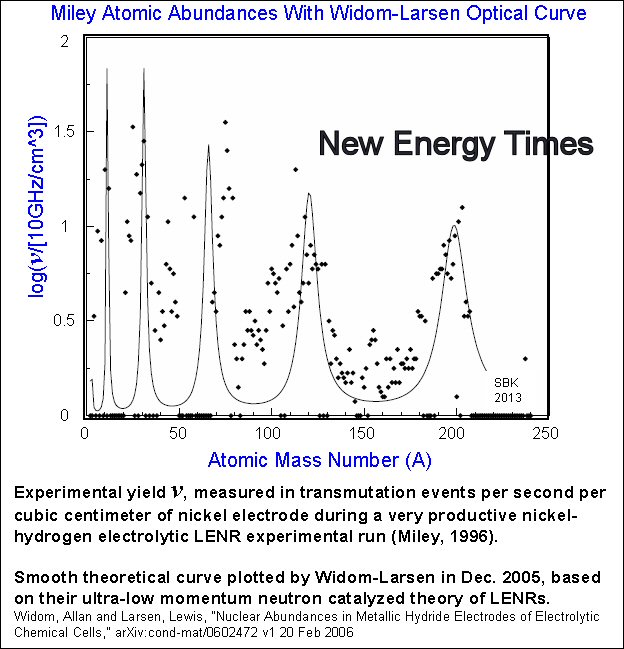
Miley Spectrum of Elemental Abundances from LENR Transmutations
Four Peaks Visible
(Z)

Graph, data and curve by Miley in 1996 from "Quantitative Observation of Transmutation Products Occurring in Thin-Film Coated Microspheres During Electrolysis," ICCF-6. Six runs are shown in this graph; all producing similar curves.
Miley Spectrum of Elemental Abundances from LENR Transmutations
Five Peaks Visible (A)

Lines drawn by George Miley in 1996. Source: "On the Reaction Product and Heat Correlation for LENRs. in 8th International Conference on Cold Fusion," which comes from G. H. Miley, “Possible Evidence of Anomalous Energy Effects in H/D-Loaded Solids—Low Energy Nuclear Reactions (LENRs),” Journal of New Energy, 2, No. 3-4, pp.6-13, (1997).
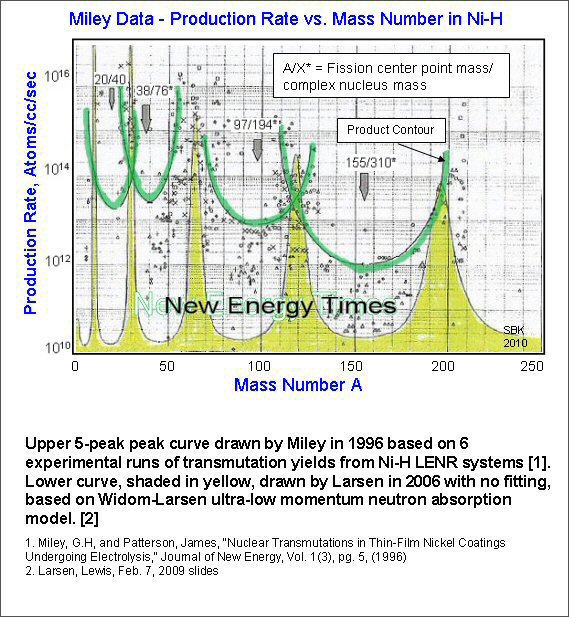
See related paper: Edward Anders and Nkolas Grevesse, "Abundances of
the Elements: Meteoritic and Solar," Geochimica et Cosmochimica Acta
(ISSN 0016-7037), vol. 53, p. 197-214, Jan. 1989
Mizuno Spectrum of Elemental Abundances from LENR Transmutations

Mizuno's data show a similar, but not identical multipeak pattern of
atomic abundances. Miley's peak curve is based on data from multiple
runs; Mizuno's data in this graph is based on the analysis of one run.
The groupings are slightly different between Miley and Mizuno and this
reflects the difference in starting seed-materials and neutron
production.
Mizuno: "Count rates for Pd electrode electrolyzed in heavy water
solution observed by SIMS measurement. Elements are mostly grouped in
four ranges of mass number: lightest elements under mass 50, light
elements from 50-80; middle elements from 100-140; and heavy elements
from 180-208." Source: "Isotopic Distribution for the Elements Evolved in Palladium Cathode After Electrolysis in D2O Solution"
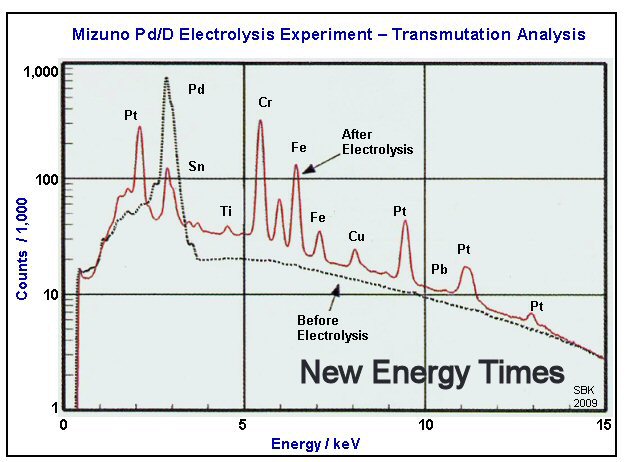
Mizuno: "EDX Spectra from the Pd rod before and after the electrolysis: 1.0 Mol LiOH-D2O, 378K, 0.2 A/cm^2 for 2.76x10^6s.
Source: "Isotopic Distribution for the Elements Evolved in Palladium Cathode After Electrolysis in D2O Solution"
Mizuno-Miley-Widom/Larsen Correspondance
Data points (in blue and red): Plotted by Mizuno
Miley data curve (in green): Drawn by Miley
Widom-Larsen theory curve (in purple): Drawn by Larsen
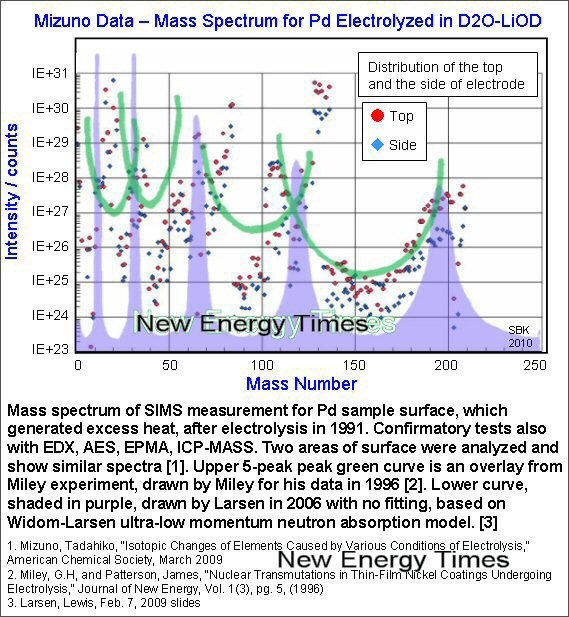
Where Mizuno identified a range for the peaks he observed[1], they equate to mass numbers 65, 120 194. Where Miley identified a range for the peaks he observed[2], they equate to mass numbers 25, 65, 120 and 200. Widom and Larsen calculated the transmutation peaks[3], based on their theoretical model, to occur around mass numbers 12, 31, 62, 117 and 206.
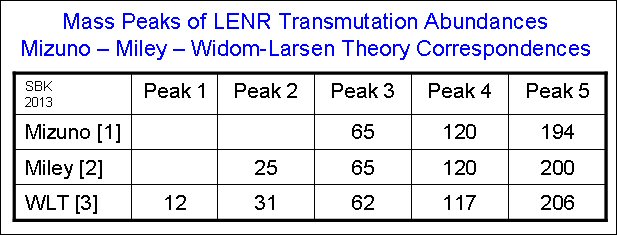
1. Mizuno, Tadahiko, Ohmori, Tadayoshi, Akimoto, Tadashi, Kurokawa,
Kazuya, Kitaichi, Masatoshi, Inoda, Koichi , Azumi, Kazuhisa, Simokawa,
Shigezo, and Enyo, Michio, "Isotopic Distribution for the Elements Evolved in Palladium Cathode After Electrolysis in D2O Solution,"
Proceedings of the Sixth International Conference on Cold Fusion:
Progress in New Hydrogen Energy, Hokkaido, Japan, Oct. 13-18, 1996;
Okamoto, M., Ed.; New Energy and Industrial Technology Development
Organization: Tokyo, (1996). Also published in Denki Kagaku (Japanese Journal of Electro-Chemistry,) 64 (11), p. 1160-1165, (1996)
2. Miley, George H., "On the Reaction Product and Heat Correlation for LENRs,"
Proceedings of the 8th International Conference on Cold Fusion, Lerici
(La Spezia), Italy, Italian Physical Society, Bologna, Italy (2000)
3. Widom, Allan and Larsen, Lewis, "Nuclear Abundances in Metallic Hydride Electrodes of Electrolytic Chemical Cells,"
Preprint, February 20, 2006
|
Back to Top
Third-Party References |
David Nagel (Chairman of ICCF-14) - 2005: “…may prove to be a viable mechanism”
(Nagel Slides May 11, 2005) (Nagel Slides Sept. 16, 2005) |
| Lino Daddi (Physics professor, Italian Naval Academy): "Perhaps
we have a theory that explains all the anomalous phenomena. The
transmutation observed from Yasuhiro Iwamura [Mitsubishi Heavy
Industries] are explained without the problematic multiple reactions of
Takahashi." |
| Brian Josephson (1973 Nobel laureate in physics) - 2005: “This paper is probably highly significant, since the physics may well be sound.” |
| George Miley (Professor emeritus, University of Illinois) - 2006: "From a first look, this theory agrees with the distinctive multipeak reaction product data from my experiments amazingly well." |
| David Rees- SPAWAR (Particle Physicist) -2006: “…as far as I can tell correct” |
| SPAWAR LENR Research Group - 2007: "We
find that Widom and Larsen have done a thorough mathematical treatment
that describes one mechanism to create...low-energy neutrons." |
| Defense Threat Reduction Agency - 2007: "New theory by Widom[-Larsen] shows promise; collective surface effects, not fusion." |
| Richard Garwin (Nuclear physicist, key participant in the Manhattan Project and designer of the first hydrogen bomb) - 2007: “…I didn’t say it was wrong” |
| Dennis M. Bushnell (Chief Scientist, NASA Langley Research Center) - 2008: "Now, a Viable Theory" (page 37) |
| Johns Hopkins University - 2008, (pages 25 and 37) |
| Pat McDaniel (retired from Sandia N.L.): "Widom Larsen theory is considered by many [people] in the government bureaucracy to explain LENR." |
| J. M. Zawodny (Senior Scientist, NASA Langley Research Center) - 2009: "All
theories are based on the Strong Nuclear force and are variants of Cold
Fusion except for one new theory. Widom-Larsen Theory is the first
theory to not require 'new physics'.” |
| Randy Hekman (2012 Senatorial Candidate) - 2011: "This theory explains the data in ways that are totally consistent with accepted concepts of science." |
| CERN March 22, 2012 Colloquium |
| Marty K. Bradley and Christopher K. Droney - Boeing (May 2012) "The Widom-Larson theory appears to
have the best current understanding." |
| |
Back to Top
Citations in Other Published Papers or Books |
| Kozima, Hideo, "The Science of the Cold Fusion Phenomenon, ISBN 0-080-45110-1, Section 3.2.5.4, p. 95 (2006) |
| Daddi, Lino, "Virtual Neutrons In Orbital Capture And In Neutron Synthesis" |
| Daddi, Lino, "Hydrogen Miniatoms" |
Back to Top
In the News Media |
| New Energy Times Issue #13 (Krvit) - Nov. 10, 2005: "Newcomers to Condensed Matter Nuclear Science Rock the Boat" |
| New Energy Times Issue #15 (Krvit) - March 10, 2006: "Widom-Larsen Low Energy Nuclear Reaction Theory, Part 3" |
| New Energy Times Issue #21 (Krvit) - March 16, 2007 "Widom Larsen Theory Debate" |
| Chicago Tribune (Jon Van) - April 16, 2007: "Nuclear reactions may produce phones’ power” |
| Institute of Science in Society (Mae-Wan Ho) - Oct. 23, 2007: "How Cold Fusion Works" (Feauturing Widom/Larsen, Krit Prasad Sinha and Andrew Meulenberg, Xing Zhong Li, Talbot Chubb) |
| Institute of Science in Society (Mae-Wan Ho) - Oct. 24, 2007: "Transmutation, The Alchemist Dream Come True" |
| New Energy Times Issue #26 (Krvit) - January 11, 2008: "The Widom-Larsen Not-Fusion Theory" |
| Larsen Interview with Robert Piccioni on WebTalkRadio - Nov. 8, 2009 |
Larsen Interview with Sandy Andrews on Blogtalkradio -April 17 , 2010
“LENR
is way bigger than IBM, way bigger than the United States,” Lewis
Larsen, of Lattice Energy LLC, told Sandy Andrew of blogtalkradio on
April 17.
Among the subjects they covered were the following: the differences
among LENR, fusion and fission; an introduction to weak-interaction
concepts and collective effects; possible practical implications of
LENR and commercial applications; and examples of low-energy nuclear
reactions going back a hundred years. |
Back to Top
Back to Top
|
|
|